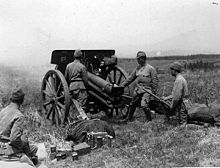Type 91 10 cm howitzer
| Type 91 10 cm 105 mm howitzer | ||
|---|---|---|
Breech Interrupted screw | | |
| Recoil | Hydro-pneumatic | |
| Carriage | Split trail, demountable recoil spade plates, trail blocks integral to trails. Wheels and Tires or Steel tires on artillery wheels. | |
| Elevation | -5° to +45° | |
| Traverse | 20° right,20° left | |
| Rate of fire | 15 Minutes 2 rpm Maximum 6-8 rpm Continuous 50-60 rph | |
| Muzzle velocity | 546 m/s (1,791 ft/s) | |
| Maximum firing range | 10,771 m (11,779 yd) | |
| Feed system | Manual | |
| Sights | Panoramic | |
The Type 91 10 cm howitzer (九一式十糎榴弾砲, Kyūisshiki Jyūsenchi Ryūdanhō) was a 105 mm (4.13 in)
History and development

The Type 91 10 cm howitzer was an orthodox design howitzer, based largely on contemporary French Canon de 105 mle 1913 Schneider howitzers ordered during the late 1920s by the Japanese Army Technical Bureau for evaluation purposes. It was intended to supplement, and eventually supersede the largely obsolete Type 38 15 cm howitzer, which had been in service since the end of the Russo-Japanese War. Over one thousand units were produced beginning in 1931.
Design

For a weapon of modern design the Model 91 (1931) 105 mm howitzer is by U. S. standards an extremely crude-looking piece. It is much smaller and lighter than the German and U. S. howitzers of the same caliber, weighing even less than the standard 75 mm (3.0 in) guns used in Europe in World War I. Despite its lightness and its appearance of not having been quite finished, it is capable of throwing a 35 lb (16 kg) shell very nearly as far as can the heavier and far more formidable looking German 105 mm howitzer.[7]
The Type 91 10 cm howitzer was a standard 105 mm artillery piece of extremely light construction relative to range and weight of projector.
unusual, in that the numbering is reversed from American, British, German, French and Italian charge numbering systems:[7]
- Charge 1: 11,772 yd (10,764 m)
- Charge 2: 8,502 yd (7,774 m)
- Charge 3: 6,322 yd (5,781 m)
- Charge 4: 5,123 yd (4,684 m)
Variants

Early models of the Type 91 had wooden spoked wheels, but later versions had steel wheels with
Combat record
Type 91 10 cm howitzer was used in large numbers in front line combat service from the time of the
Weapons captured by the Chinese during the Second Sino-Japanese War, or abandoned in China at the time of the
References
Notes
- ^ Military catalogue of the Japanese military, p. 96
- ^ Banking and Monetary Statistics, 1914-1941, Part I, p. 673
- ^ Chamberlain, Light and Medium Field Artillery for the early version with spoked wheels.
- ^ "101". www.quarryhs.co.uk. Retrieved 2017-09-05.
- ^ https://www.quartermastersection.com/japanese/artillery/697/Type91FH
- ^ https://www.quartermastersection.com/japanese/artillery/697/Type91FH
- ^ a b c d War Department Special Series No 25 Japanese Field Artillery October 1944
- ^ a b US Department of War. TM 30-480, Handbook on Japanese Military Forces
- ^ [1] Taki's Imperial Japanese Army page
Bibliography
- Bishop, Chris (eds) The Encyclopedia of Weapons of World War II. Barnes & Nobel. 1998. ISBN 0-7607-1022-8
- Chamberlain, Peter and Gander, Terry. Light and Medium Field Artillery. Macdonald and Jane's (1975). ISBN 0-356-08215-6
- Chant, Chris. Artillery of World War II, Zenith Press, 2001, ISBN 0-7603-1172-2
- McLean, Donald B. Japanese Artillery; Weapons and Tactics. Wickenburg, Ariz.: Normount Technical Publications 1973. ISBN 0-87947-157-3.
- Mayer, S.L. The Rise and Fall of Imperial Japan. The Military Press (1984) ISBN 0-517-42313-8
- War Department Special Series No 25 Japanese Field Artillery October 1944
- US Department of War, TM 30-480, Handbook on Japanese Military Forces, Louisiana State University Press, 1994. ISBN 0-8071-2013-8
- "兵器臨時定価、予価、表送付の件 Military catalogue of the Japanese military". National Archives of Japan. Ministry of the Army.
- "Banking and Monetary Statistics, 1914-1941, Part I". Federal Reserve Bank of St. Louis. Board of Governors of the Federal Reserve System (U.S.).
